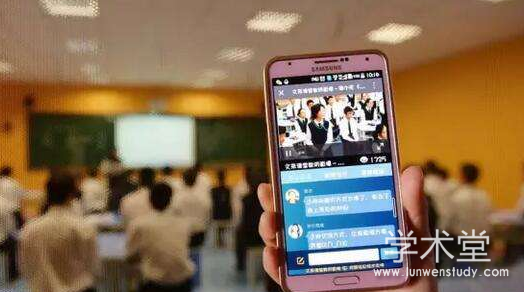摘 要
随着科学技术的不断进步,流媒体技术正在蓬勃发展并且日趋成熟。基于流媒体技术的视频直播已经融入人们的生活,目前主要应用于娱乐秀场直播,但在教学领域的应用比较少见。相较于传统课堂的教学模式,网络在线教学具有很多无法比拟的优势。随着计算机网络技术的发展和电子产品的普及范围扩大,网络在线教育这种新型教学模式将会成为流行趋势。
本论文提出了一种基于流媒体技术的网络在线教学和具备师生实时互动交流的教学模式,并通过设计实现一套基于流媒体的教学直播系统将这种教学模式得以实现。在这套系统中一方面教师可以随时随地远程授课,学生可以随时随地远程学习;另一方面通过系统里的师生互动模块,加强了师生之间的沟通交流。
本论文的研究内容及创新点主要包括以下几个方面:
(1)深入研究流媒体相关技术,研究并开发出一套以 RTMP 直播协议为基础,Nginx 服务器为核心的流媒体直播系统。本系统具备直播模块化、高清视频流及流畅性好的特点。
(2)深入分析传统课堂及网络在线教育的教学模式,提出一种将课堂直播与聊天室相结合的教学直播互动模式。通过这种模式,增进师生之间的沟通交流,提高教学质量。
(3)深入研究服务器端开发技术,研究并开发出一套服务于管理教学直播的教学直播管理系统,使得直播资源得到合理分配管理,提高相关人员的工作效率,提升系统体验感。
关键词:流媒体,在线教育,传统课堂,课堂直播,师生互动

Abstract
With the continuous progress of science and technology, streaming mediatechnology is booming and maturing Video live broadcasting based on streamingmedia technology has been integrated into people’s lives At present, it is mainly usedin entertainment show live broadcasting, but its application in the field of teaching isrelatively rare Compared with the traditional classroom teaching mode, onlineteaching has many incomparable advantages Because of computer networktechnology’s development and the popularity of electronic products’expansion, onlineeducation, a new teaching mode, will become a popular trend
In this paper, a teaching mode based on streaming media technology andreal-time interaction between teachers and students is proposed, and the teachingmode is realized by designing and implementing a live streaming media-basedteaching systemIn this system, on the one hand, teachers can teach at any time andanywhere, and students can learn at any time and anywhere On the other hand,through the teacher-student interaction module in the system, communication betweenteachers and students is strengthened
The following is a detailed introduction of the research contents and maininnovations:
(1)In-depth study of streaming media technology, research and developmentof a live streaming media system based on RTMP protocol, Nginx server as thecoreThe system has the characteristics of live broadcast modularization,high-definition video flow and good fluency
(2)This paper deeply analyses the traditional classroom and online educationteaching mode, and puts forward an interactive teaching mode which combinesclassroom live broadcasting with chat roomThrough this mode, the communicationbetween teachers and students can be improved and the quality of teaching can beimproved
(3)Deeply study the server-side development technology, research and develop a teaching live broadcasting management system serving the management ofteaching live broadcasting, so that the live broadcasting resources can be rationallyallocated and managed, improve the efficiency of relevant personnel, and enhance thesense of experience of the system
Key words: streaming media Online education,Traditional classroom,Live broadcast in class,Interaction between teachers and students
目录
1 绪论
1.1 课题研究背景及意义
在科学技术快速发展的同时,不仅人们的生活方式发生了改变,获取信息的方式也发生了变化。传统获取信息的方式主要为书籍和传统课堂。在相同的地点、相同的时间,教师通过面对面的方式在教室对学生们进行授课。传统课堂的优势在于教师可以根据上课内容,灵活安排授课方式;在课堂上学生可以与老师面对面的实时交互向教师及时提出问题,教师根据提出的问题,在课堂及时答疑解惑。
传统课堂不仅优势明显,而且弊端也同样明显。最大的弊端在与受限于时间、地点的束缚。当教师由于某种原因不能到教室授课或者学生不能到教室听课的情况发生时,传统课堂的劣势就显现出来了。除此之外,我们现在处于一个知识井喷的时代,新的事物和新的技术不断涌现出来,对个人的要求也越来越高。为了不落后于社会发展的快速步伐,不断地自主学习—终身学习成为现代社会的必然要求。在这种背景下,随着计算机网络技术的不断发展,网络在线教育孕育而生。
网络在线教育在传统课堂的基础上去其糟粕取其精华并将其发扬光大。随着互联网及电子产品的普及,网络在线教育让人们挣脱时间和地点的束缚,可以随时随地通过电子产品上网的方式去接受教育。互联网覆盖范围日渐增加,也将使网络在线教育覆盖范围不断增大,让更多的人通过网络接受教育,使教育资源分配更加平衡,让终身学习,跨学科学习成为现实。受益者不仅仅是学生,教师也同样从中受益。网络在线教育丰富了教师的教学模式,扩大了教学规模,提升教学效率。最重要的是通过实时交互的方式,使得教学质量得到提升。
在国内,网络在线教育还仅仅是处于起步的阶段。在线直播技术主要运用于具有娱乐性质的秀场直播,然而真正意义上成熟运用于在线教育的直播系统还很少。市面上的网络在线教育直播系统的教学模式主要是以点播的方式实现,并非是实时直播的形式,因此这类系统不具备实时性,缺少师生互动,老师无法及时解答学生的疑惑。
基于上述背景,随着计算机网络技术不断发展,网络在线教育必然会成为未来的趋势。因此,开发一套服务于教学,支持在线实时直播课程的系统具有重大意义。
【由于本篇文章为硕士论文,如需全文请点击底部下载全文链接】
1.2 国内外研究现状
1.3 论文研究内容
1.4 论文结构安排
1.5 本章小结
2 技术原理分析
2.1 流媒体技术概述
2.2 流媒体原理介绍
2.2.1 流媒体技术组成
2.2.2 流媒体传输方式
2.3 服务器开发相关技术
2.3.1 CentOS
2.3.2 MySQL
2.3.3 ThinkPHP
2.4 本章小结
3 教学直播系统设计分析
3.1 系统总体设计分析
3.2 客户端功能需求分析
3.3 后台管理功能需求分析
3.4 本章小结
4 直播模块设计与实现
4.1 系统设计架构
4.2 编码端设计与实现
4.2.1 音视频压缩编码
4.2.2 编码工具工作流程
4.2.3 编码工具的选择
4.2.4 编码工具的实现
4.3 流媒体网络协议的选择
4.4 流媒体服务器设计及实现
4.4.1 直播流传输过程解析
4.4.2 流媒体服务器的比较及选择
4.4.3 Nginx 服务器的搭建与实现
4.5 客户端播放器的设计及实现
4.6 本章小结
5 教学直播管理模块设计与实现
5.1 系统设计架构
5.1.1 系统总体设计
5.1.2 技术选型
5.1.3 MVC 开发模式
5.2 客户端模块设计与实现
5.2.1 登录注册模块
5.2.2 直播课程模块模块
5.2.3 师生互动模块
5.2.4 控制台模块模块
5.3 服务端模块设计与实现
5.3.1 授权管理模块
5.3.2 服务器配置信息模
5.3.3 直播管理模块
5.3.4 系统管理模块
5.4 数据库设计与实现
5.4.1 数据库设计原理
5.4.2 需求分析
5.4.3 概念结构设计
5.5 本章小结
6 总结及展望
致谢
参考文献





